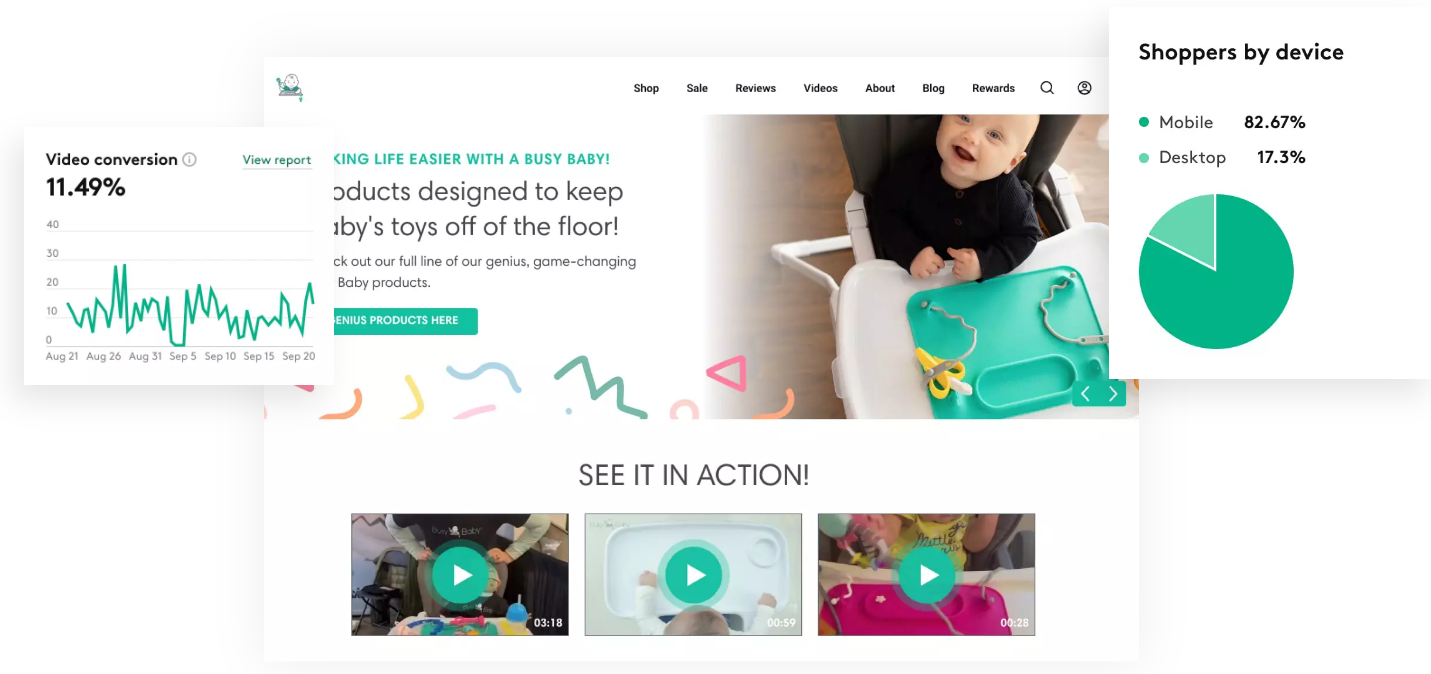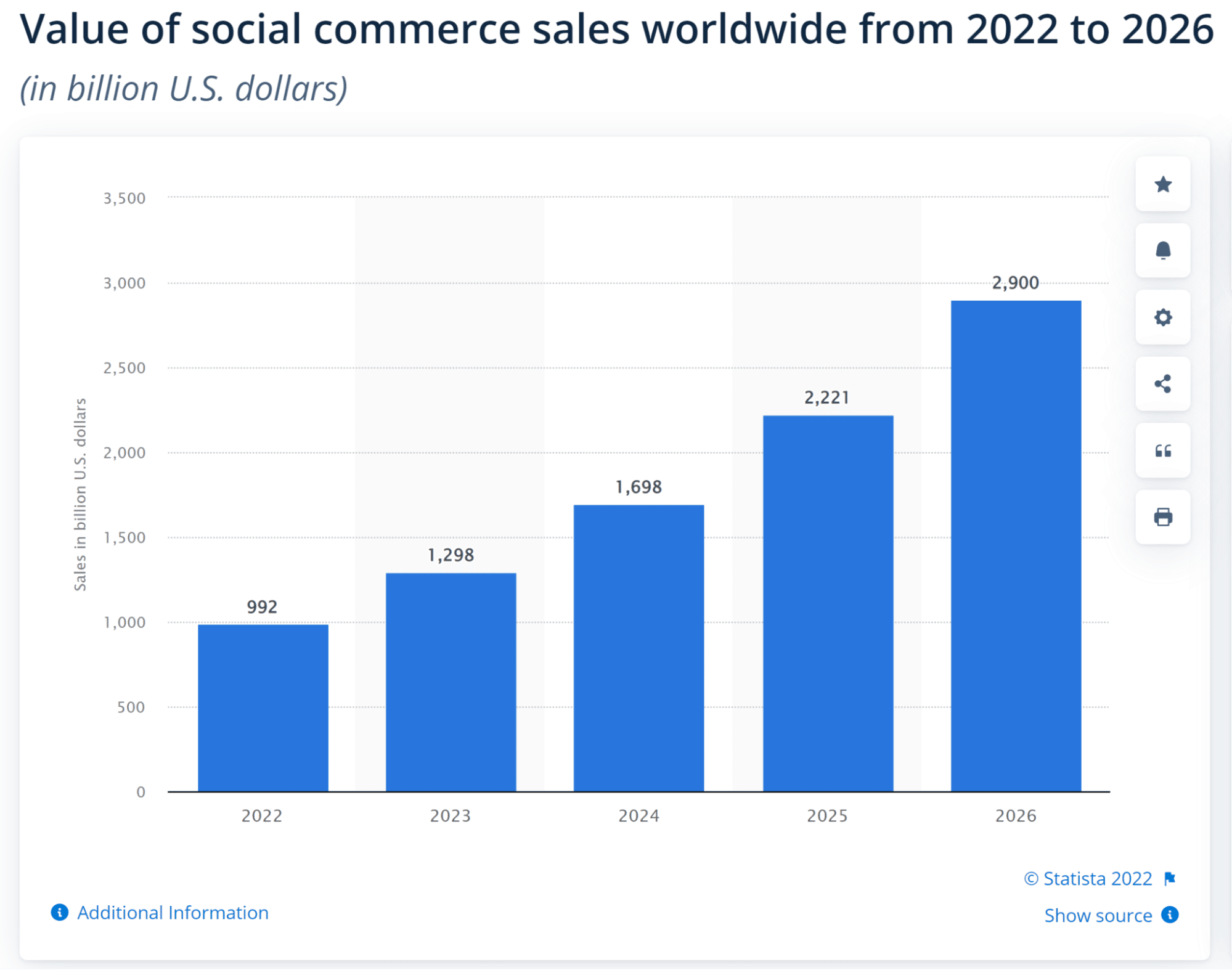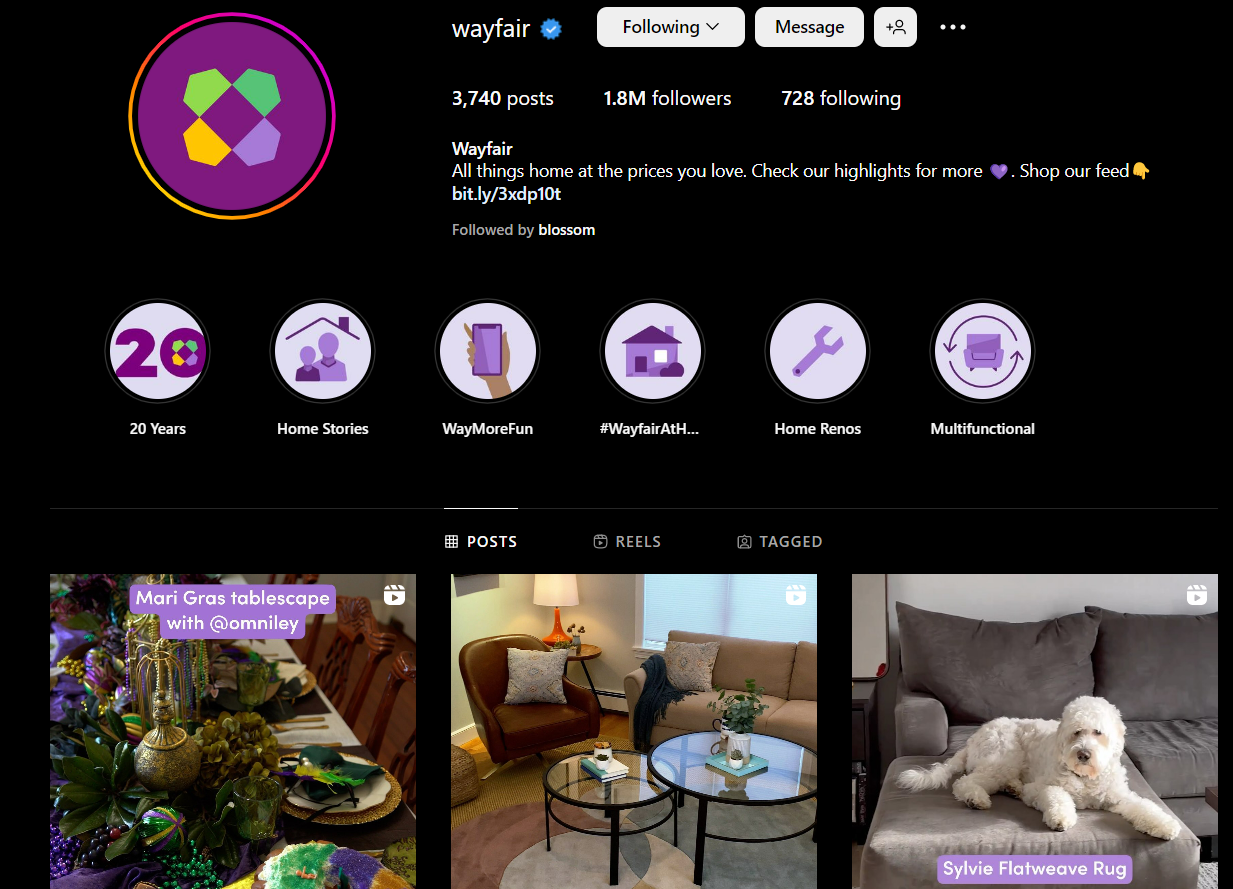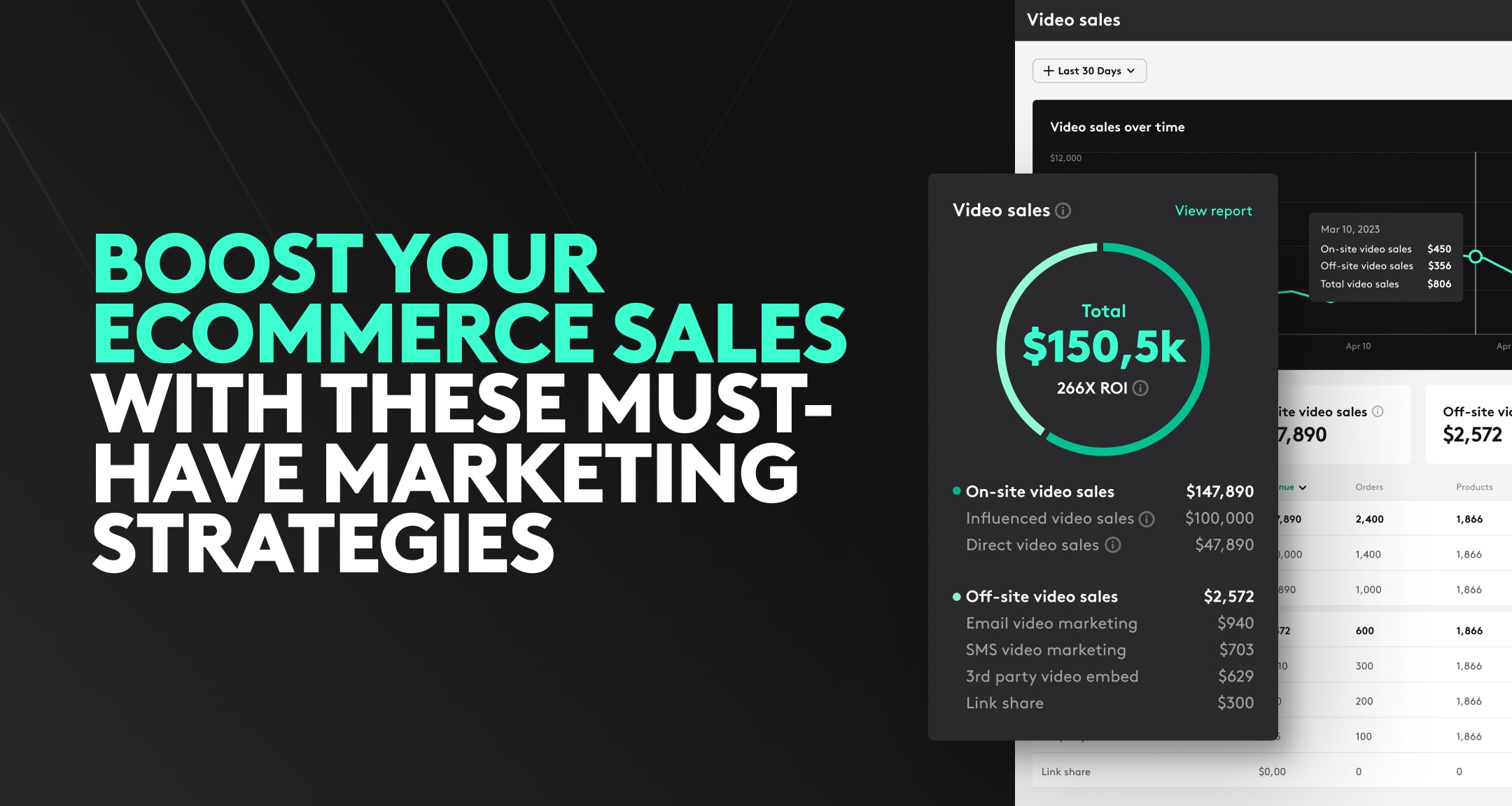Share
Wondering how to market your eCommerce store in 2023?
We've got you covered.
Below is an ultimate eCommerce marketing checklist that will help you reach your target audience at precisely the right moment, ensuring that your products get the attention they deserve.
Let's get started!
Website optimization
Optimizing your eCommerce website is no longer something you can take for granted. The competition is fierce, and your customers are more demanding than ever.
That's why you need to optimize your website on all fronts: branding, customer experience, search optimization, etc.
Here's how you can check off every aspect of your site:
- Implement shoppable videos
- Use a sitemap
- Keep consistent branding
- Show
1. Implement shoppable videos
Shoppable videos allow your viewers to buy products directly from your videos. By integrating product links, buy buttons, and storytelling elements, shoppable videos merge visual storytelling with commerce, creating an immersive and streamlined shopping experience for the viewer.
Shoppable videos offer numerous benefits for your store, such as,
-
Improve engagement and conversion rates.
-
Increase product awareness and sales.
-
Provide a seamless customer journey.
Videowise allows you to easily embed shoppable videos on your Shopify store and increase your conversion rate.
Want to see Videowise in action? Book a demo with us today!
2. Use a sitemap
A sitemap is a file that provides information about the pages, videos, and other files on your website and how they're related to each other. It helps search engines like Google crawl your site more efficiently.
If your website is large and has a lot of rich media content like videos and images, a sitemap can be really helpful. However, if your site is small and has few media files or news pages, you may not need a sitemap.

A sitemap doesn't guarantee that all the items in it will be crawled and indexed, but it can improve the crawling of larger or more complex sites.
Google suggests the following steps for creating a sitemap:
-
1. Follow the best practices for sitemaps, including size limits, sitemap location, and URLs included.
-
2. Use fully-qualified, absolute URLs in your sitemap and include only the URLs you want to see in Google's search results.
-
3. For larger files or more URLs, break your sitemap into multiple sitemaps and submit them to Google.
-
4. Use the UTF-8 encoding for your sitemap and post it at the site root to affect all files on the site.
-
5. For a very basic sitemap, use an XML sitemap format that includes the location of a single URL.
-
6. If your sitemap only has web page URLs, provide Google with a simple text file containing one URL per line.
-
7. To create a sitemap, let your CMS generate one for you, manually create one, or automatically generate one depending on your site's size.
-
8. Submit your sitemap to Google Search Console and monitor its performance.
3. Keep consistent branding
Keeping consistent branding across your website helps you create a strong and memorable image for your business. Whenever people visit your website, they will easily recognize and understand its association with your other brand assets they find on social, email, or any other channels.
Here are a few simple ways to ensure consistency on your eCommerce website:
-
Use the same colors, fonts, and logos across your website.
-
Make sure that all pages have a consistent style, layout, and design, so they're easy to navigate.
-
Develop a consistent tone and voice for your brand and use it across all pages of your website.
-
Ensure all of your brand elements are easy to read, even on mobile devices or when viewed as small thumbnails.
-
Add social buttons to help visitors easily connect with you on social.
4. Show featured products
Showing featured products on an eCommerce website can increase the visibility of products you want to promote. It can also enhance customers' experience by helping them find products they are interested in, ultimately leading to more engagement and sales.
Moreover, search engines view featured products as important and relevant to the website, which can improve search rankings and ultimately improve the website's overall SEO efforts.
But how can you decide which products you should feature on your homepage and other important website pages?
Here are some tips to help get you started:
-
Identify popular products based on sales volume, profit margins, and customer reviews.
-
Consider seasonal trends and select products that are popular during the season.
-
Feature new or exclusive products to attract attention and generate sales.
-
Select products that look great in photos and will catch the eye of your customers.
Bonus: You can also add interactive videos so the users can see how your featured products look in different settings and buy them with just a click of a button.
-
Lastly, identify products that are frequently viewed or clicked on, and use this data to choose your featured products.
5. Optimize your SEO titles and meta descriptions
Finally, one of the most crucial aspects of increasing your search traffic is to write search-optimized meta titles and descriptions for your product pages.
Here are some tips for writing the best SEO titles and meta descriptions:
-
Determine the primary keyword for each product page and include it in the meta title and description.
-
Keep the meta title concise and within 60 characters, including the primary keyword.
-
Write a compelling meta description that reflects the content of the page, using 150-160 characters.
-
Include unique selling points or benefits of the product in the meta description to entice users to click through to the page.
-
Avoid duplicating meta titles and descriptions across multiple pages.
-
Use action-oriented language, such as "buy," "shop," or "learn," to encourage users to take action.
-
Review and update meta titles and descriptions regularly to ensure they remain relevant and effective for search and user intent.
Content marketing
Content marketing helps eCommerce websites attract and engage their target audience, build brand awareness, and drive traffic to their site.
By creating and publishing relevant and valuable content, such as blog posts, videos, infographics, and social media updates, eCommerce sites can establish themselves as industry experts and thought leaders in their niche.
With almost 90% of web pages getting no traffic from Google, it becomes crucial for you to plan your content marketing strategy and execute it effectively. When done right, content marketing can help you build relationships with your customers and increase their loyalty to your brand, as it did for Busy Baby Mat.
Busy Baby Mat is a small, veteran, and family-owned business that understands the challenges of parenthood. Their mission is to make life easier for busy parents everywhere.
They have a dedicated blog section where they provide useful advice and insights for parents. Their articles cover various topics, from tips for traveling with a baby to keeping your child entertained while running errands. These articles are not only informative but also keyword-focused, making them easy to find for those searching for specific information about parenting.
Busy Baby Mat understands that seeing its products in action can be a powerful way to show its value.
That's why they use shoppable videos on their homepage to demonstrate how their products work in real-life situations. This approach has paid off, with a conversion rate of 11.49%, showing that parents trust and appreciate the products that Busy Baby Mat offers.

Learn how Videowise helped Busy Baby Mat turn videos shoppable and monetize them on-site.
Now let's see how you can effectively plan your content marketing so you won't end up in the 90% of businesses that fall short of their goals.
1. Find popular keywords
Identify the most relevant and popular search terms your target audience uses to find products like yours and create a content strategy around them.
-
Start with basic keywords related to your products or services.
-
Use Google's Keyword Planner tool to find related keywords that people search for.
-
Focus on using more specific keywords that are less competitive to rank for, like "women's running shoes for flat feet" instead of just "running shoes."
-
Look at your competitors' websites and see what keywords they use to rank highly.
-
Use Google Trends to see how popular your chosen keywords are over time, so you can adjust your strategy accordingly.
-
Make sure the content you create matches what people are searching for, whether it's informative or purchase-driven.
-
Look at social media to find relevant hashtags and see what people are talking about in your niche.
2. Write SEO-friendly content
The next step is to create content that is optimized for search engines, including the use of targeted keywords, meta tags, and other on-page SEO factors that will help you rank higher in search results.
Here's how you can create SEO-friendly content that is valuable to your audience as well as optimized for Google:
-
Create an outline for every post to make sure it includes relevant keywords naturally.
-
Create high-quality content that provides value to your audience. Use proper grammar and formatting, including subheadings and bullet points, to make the content more readable.
-
Use your chosen keywords in the content in a natural way. Try to include them in the page title, meta description, headers, and image alt tags, wherever possible.
-
Interlink to other relevant pages within your website to improve the overall structure and navigation. This can help search engines crawl your site and understand the relationship between your pages.
-
Make sure your website is mobile-optimized and responsive, as Google prioritizes mobile-friendly websites when ranking search results.
-
Use tools like Google Analytics to track your website traffic and see how your content performs.
3. Use visual media
Use images, videos, and other visual media to make your content more appealing and engaging, just like Busy Baby Mat did with interactive videos. If you want to use images on your website, pick ones that make sense and look good. Also, give each image an alt text so search engines can understand what it is. Finally, make sure the images don't take too long to load or make your website slow.
4. Distribute your content
Share your content across various channels, including social media, email marketing, and other online platforms, to reach as many potential customers as possible.
For example, if you have written a high-intent blog post for your target audience, here are some specific ways how you can distribute and promote it on various channels:
Social media:
-
Share the blog post on your social media channels (Facebook, Twitter, LinkedIn, Instagram, etc.).
-
Use relevant hashtags to increase visibility and reach new audiences.
-
Create custom graphics or images to accompany your blog post and share them on social media.
Email marketing:
-
Include a link to your blog post in your email newsletter.
-
Segment your email list based on interests or engagement level and send targeted email campaigns to subscribers who are most likely to be interested in your blog post.
Influencer outreach:
-
Reach out to relevant influencers in your industry or niche and ask if they would be interested in sharing your blog post with their audience.
-
Offer to write a guest post for their website in exchange for sharing your blog post with their audience.
Content syndication:
-
Contact relevant industry publications or websites and offer to syndicate your blog post on their site.
-
Include a call-to-action in your blog post that encourages readers to share the post on their own social media channels or website.
Paid promotion:
-
Use paid social media advertising to promote your blog post to a targeted audience.
-
Use Google Ads to promote your blog post to users searching for related topics.
-
Use native advertising platforms to promote your blog post on relevant websites or blogs.
Lastly, evaluate the performance of your content and identify what is working well, then focus on doubling down on those successful strategies.
Social media marketing
Social media has become a powerful tool for eCommerce brands to promote their products and services to their target market.
According to recent estimates, global sales through social media platforms reached nearly 1 trillion U.S. dollars in 2022, which is expected to grow. Forecasts suggest that by 2026, social commerce sales could reach as high as 2.9 trillion U.S. dollars.

Source: Statista
That's a huge opportunity for eCommerce brands to reach a wider audience and increase sales. By establishing a strong presence on social media platforms and engaging with their target audience, eCommerce brands can
-
build brand awareness
-
drive traffic to their website
-
ultimately increase their sales and revenue.
One such example is Wayfair.
Wayfair is a home décor brand that uses its social media presence to engage with customers and promote its products.
Their Instagram page offers tons of home décor inspiration, tips, and guides to help customers make informed decisions when buying or decorating their homes.
Moreover, Wayfair also makes it easy for their customers to buy a single product or the entire look they like by simply clicking on the link in their bio that redirects customers to the Wayfair online store.
It's worth noting that Wayfair is making the entire process of buying their product simple and fast for their customers -- and that makes a huge difference, as proven by its 1.8 million Instagram followers.

Believe it or not, social media is not just a channel to post photos of your new clothes or shoes. It's a great way to promote your business and attract potential customers.
Here's an easy-to-follow social media strategy that can help you market your eCommerce store.
1. Set goals
Setting a goal means deciding what you want to achieve through your social media efforts, whether it's to
-
Increase your website traffic
-
Boost your sales
-
Get more followers
Once you have a clear goal, it will be easier for you to make further decisions.
2. Identify your target audience
Knowing your ideal customers will help you create better social media content that matches their interests.
For instance, if your target audience hangs out on Instagram, you can share more pictures about your products and redirect users to your website, where they can buy the products directly, just like Wayfair does.
Understanding your target audience will help you make better decisions about your products, prices, and promotions and reach the right people with the right message -- leading to more traffic, sales, and loyal customers.
3. Prioritize channels for your social media strategy
Not all social media platforms are created equal. It's important to figure out which ones work best for your brand and target audience so that you can make the most of each platform.
For instance, if you're marketing a product to teenagers, then Instagram or TikTok might be better platforms for you than Facebook.
Prioritizing social media channels can save you time and help you use your resources more effectively.
It can be difficult to work out a social media strategy successfully, especially if you're trying to be on all platforms at once.
However, by concentrating on the selected platforms that work best for your business, you can avoid spreading yourself too thin.
You can then use your saved resources to focus on creating great content, interacting with your audience, and tracking the impact of your social media efforts that can help you get better results in less time.
4. Optimize your social media accounts
As an eCommerce brand, optimizing your social media profiles can help you increase visibility, establish brand credibility, drive better engagement, and provide a competitive advantage.
Here is a step-by-step process to optimize your brand's social media profiles:
-
Set up an account on each platform and verify it with a valid phone number or email address.
-
Add your website link, logo, and contact information on each profile.
-
Fill in all the fields, including cover photos and bio.
-
Create a business page wherever an option is provided.
-
Add a call to action on each profile.
-
Create an editorial calendar.
-
Collect ideas and plan content.
-
Use an automation tool for managing all your social media accounts.
Email marketing
Your email list is an asset to your business. It can help you grow your business and reach more customers or clients. Email marketing is one of the most effective tools for promoting your products or services, building relationships with customers, and growing your business.
According to a report by Litmus, email marketing has an average ROI of $45 for every $1 spent in the retail and eCommerce industry. It's no wonder that most eCommerce businesses have made email marketing a default marketing channel.
Let's take an example of one such business:
Wool and the Gang, a DIY fashion brand, uses email marketing to connect with customers. When a new customer signs up, they receive a welcome email that instantly gives them a 15% off coupon code. The email has a brief introduction about the company and then shows how to use its products. There's also a short survey where they ask customers to share their birthdays.

At last, the email includes links to the company's social media profiles and a few CTAs like "Download Free Patterns" and "See What's New." They also show the number of reviews they've received to build trust.
Such email campaigns can greatly help eCommerce brands to engage with new customers and encourage them to make their first purchase.
1. Types of emails you can send
Here are the most common types of emails you can send to your customers:
-
Welcome Email (to welcome new customers and thank them for signing up)
-
Discount Code Email (to promote a sale or discount)
-
Customer Review Email (to ask for reviews from current customers)
-
Abandoned cart email ( to remind customers to complete their purchase)
-
Newsletter Campaigns (to send monthly email campaigns)
-
Referral Program (to encourage customers to refer their friends)
-
New Product Email (to promote new products or services)
-
Promotional Email (to announce new features, promotions, offers, and more)
-
Cross-selling Email (to recommend additional products to customers who have purchased one item from your eCommerce store)
Now that you understand the types of emails you can send to your customers, it's time to put together a plan for sending them. Here are some tips on how to create an effective email marketing strategy:
2. Build and clean up your email list
Building an email list is the first step toward creating an effective email marketing campaign. This involves creating a sign-up form on your website, collecting email addresses, and removing duplicate or invalid entries. Moreover, cleaning up your list ensures that the people on your email list are interested in receiving your emails.
Here are some tips for building an email list faster:
-
Create a form on your website where people can sign up to receive your emails.
-
Collect email addresses from your website's forms and other places where people can easily enter them, like comment boxes.
-
Offer something special or exclusive to people who sign up, as Wool and the Gang did with their welcome email.
-
Use a double opt-in process that confirms people's subscriptions to your emails and prevents spammers from signing up with fake accounts.
-
Use email marketing software to collect and manage your email list, so you can segment your list and send targeted messages to specific groups of people.
3. Write and design engaging email content
High-quality content is the backbone of your email marketing. It's what convinces people to open and read your email and take the actions you want. Creating personalized, relevant, and valuable content can help you build stronger relationships with your customers and increase sales.
So, how do you create great email content? Here are a few tips:
-
Write a compelling subject line: Create a subject line that is interesting and related to your email.
-
Personalize your emails: Use the customer's name and any other relevant information to make your emails feel more personalized and engaging.
-
Provide value: Offer exclusive promotions, discounts, or useful information that your customers will find valuable and appreciate.
-
Keep it short and sweet: Make sure your emails are easy to read and understand.
-
Use eye-catching design: Include visually appealing images and graphics, and use a clear and mobile-friendly layout that is easy to read. You can even add shoppable videos to your email to help customers directly buy what they want within the video.
Videowise also allows you to embed shoppable videos into your emails seamlessly.
Book a demo to learn more about it.
-
Include a clear call-to-action: Make it obvious what action you want your customers to take, such as making a purchase, signing up for a newsletter, or visiting your website.
-
Test and optimize: Continuously experiment with different parts of your emails, like subject lines, content, and design, to see what works best.
Invest in an omnichannel marketing strategy
There you have it! A comprehensive digital marketing checklist for your eCommerce store.
You can either pick one or multiple channels from the checklist and start implementing them in your marketing strategy. You can also combine multiple channels and develop an omnichannel marketing strategy that will center around your customer journey and provide a seamless experience for your customers.
For example, you can use search engine optimization and social media to drive traffic to your store and then convert them with email marketing.
When you prioritize your customers and build your business around them, you will see how much better it works than the other way around.
Lastly, to improve your customer experience further, make it easy and quick for them to find and buy the products they like with shoppable videos.
Learn more shoppable videos and how Videowise can help you create one here.
Share


.jpg?width=1800&height=952&name=Image%20for%20all%20the%20blog%20posts%20(1).jpg)


.jpg?width=420&height=420&name=live%20shopping%20top%205%20fashion%20(1).jpg)